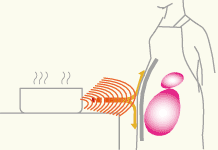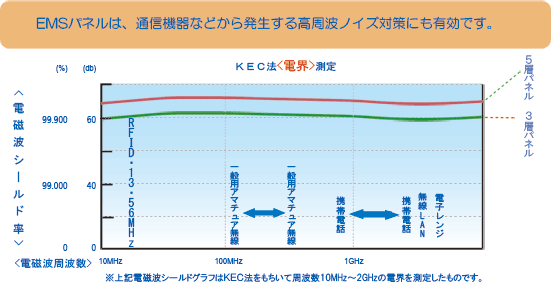Performance test data

The electromagnetic shielding graph above shows the measurement of "shielding magnetic field strength" at frequencies between 30Hz and 300KHz. EMSpanel shields low-frequency magnetic fields generated by AC currents and induction cookers, which conventional coating materials have little or no shielding performance against. The graph below shows the electric field shielding data measured by the KEC method for high-frequency electromagnetic wave noise.


Theoretical support
1. Theoretical formula for electromagnetic shielding effectiveness
![]()
![]()
The larger S, the greater the electromagnetic shielding effect. Therefore, it is necessary to select a material with a large δ for the electromagnetic shielding material. For the EMS pad, a high-permeability magnetic material sheet (120 μm thick) was used.

2. Improved electromagnetic shielding rate through multi-layering of materials
The theoretical formula for the electromagnetic shielding effect S when the material is multi-layered is shown below.

The larger S is, the higher the electromagnetic shielding effect is. Electromagnetic shielding performance is improved by laminating electromagnetic shielding materials. EMSpanel is made up of a five-layer structure of aluminum foil and high-permeability magnetic material sheets.
3. Shielding magnetic field strength measurement test
The shielding magnetic field strength is measured using the following method [Figure 2]. A tracking pulse is transmitted from a transmitting loop antenna and received by a receiving loop antenna separated by the material under test, and the shielding strength is measured.

▲ Figure 2. Shielding magnetic field strength measurement test method
The results of the shielding magnetic field strength measurement test for EMSpanel are shown in Figure 3. This sheet is made up of a five-layer structure of aluminum foil and high-permeability magnetic material sheets, and despite its thickness of 0.7 mm, a shielding magnetic field strength measurement test at the material value confirmed a maximum shielding rate of approximately 60 dB (99.9%) in low-frequency electromagnetic fields from 100 Hz to 300 kHz. It has been confirmed that the low-frequency electromagnetic field emitted by induction cookers has the strongest energy in the 20 kHz to 30 kHz range, and the shielding rate in this vicinity was confirmed to be 60 dB (99.9%).

▲Figure 3. Shielding performance measurement data
(※Note: This is a logarithmic scale of 10 squared, so it is not uniform.)
References: Latest Electromagnetic Wave Absorption and Shielding, Nikkei Technical Books
4. High reflectivity of high frequency electromagnetic waves increases the impact on other devices.
- ・Diffusion of reflected electromagnetic waves:Materials with high reflectivity scatter electromagnetic waves over a wide area, and surrounding equipment may be affected by the reflected electromagnetic waves.
- ・Electromagnetic interference (EMI):Reflected electromagnetic waves can enter other electronic devices or systems, causing electromagnetic interference and disrupting the normal operation of those devices.
- ・Increasing complexity of the electromagnetic environment:Reflected electromagnetic waves are scattered in multiple directions, complicating the electromagnetic environment and increasing the risk of electromagnetic interference occurring in unexpected places, making it difficult to predict the effects on specific equipment or systems.
- ・Reduced shielding effectiveness:When a material with high reflectivity is used, re-radiation or resonance of electromagnetic waves occurs, the expected shielding effect cannot be obtained, and control of electromagnetic waves becomes difficult.
Example: Malfunction verification test of electromagnetic wave protective clothing (CES protector) for capsule endoscopes
- In developing electromagnetic wave protective clothing for capsule endoscopes, protective clothing was created using MGnet 2-layer (approximately 40 dB) and MGnet 4-layer (approximately 60 dB) materials, and the capsule endoscope antenna was installed in seven locations on various parts of a human dummy. The capsule endoscope was embedded in the abdomen, and the person wearing each protective clothing was irradiated with electromagnetic waves in the frequency band of the telemeter. The distance at which an error occurred was measured by bringing the antenna closer.
- ・MGnet 2-layer (about 40 dB):There was no variation in the distance at which errors occurred depending on the position of the seven antennas. The distance at which errors occurred was reduced almost uniformly.
- ・MGnet 4 layers (approx. 60 dB):The distance at which errors occurred varied depending on the positions of the seven antennas, and errors occurred even from far away depending on the antenna position.
- For details, please refer to the following documents.
- Comparative study of the effects of MGnet 2-layer (approximately 40 dB) and 4-layer (approximately 60 dB) on capsule endoscopes

